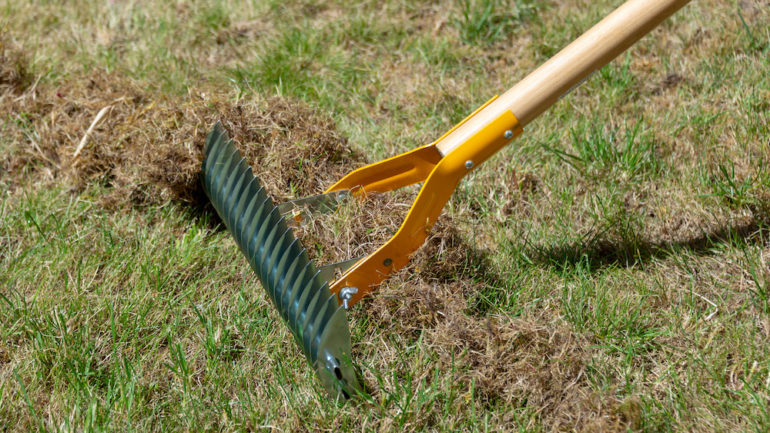If grass clippings have accumulated on your lawn, you should periodically clear the resulting thatch so that water and nutrients can penetrate the soil. Known as scarifying, this process of raking up thatch is essential for the health of your lawn. Here’s what you need to know.
What is and is not thatch
If you allow grass clippings to stay on your lawn rather than bag them, they settle into the soil and decompose. This composted organic material feeds your lawn, but over time, it forms an almost impenetrable layer above the topsoil. This layer is thatch. If you dig a core sample plug from your lawn, you will see below the grass a dark layer of thatch and then the soil below. If this layer is not cleared out once per year, the thatch becomes hard-packed, making it difficult for water to penetrate the soil.
Thatch is not the accumulated dead grass clippings beneath the living grass.
How to scarify your lawn and remove thatch
Scarifying is done in stages. The first step is to mow the grass short enough that your tools for removing thatch can reach through the live grass. Do not scalp your yard. Instead, mow once, then wait a week and mow again. Repeat this process for a few weeks. During this time, pull weeds by hand or use a weed extractor tool. Do not use an herbicide.
Water as usual as you prepare the grass. On the day that you scarify, however, do not water.
You can scarify your lawn by hand with a scarifying thatch rake. If your yard is large, however, you may prefer to use a gas or electric-powered machine. Since scarifying is a once-per-year job, check equipment rental centers to see if you can rent this equipment rather than buying.
Scarify in strips, moving back and forth across the lawn much like you mow. Then repeat the process in strips perpendicular to the first strips. As you proceed, rake and remove the thatch you have dug up.
Follow-up care
It’s good to reseed your lawn once you’ve scarified because seeds can reach the soil with thatch removed. After reseeding, apply an organic liquid lawn food mixed with water.
Now, better able to germinate seeds and absorb nutrients, your lawn will be a lush, healthy carpet of grass.
Related – Keep Your Lawn Looking Great All Year Long


